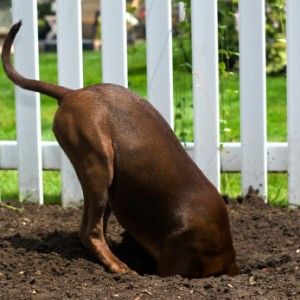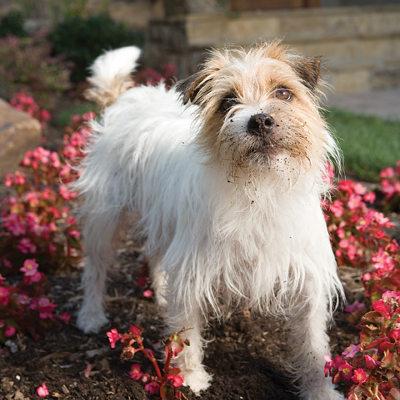By Jim Tedford, Director of Animal Affairs and Alliances
When you adopted your pet, you never expected they would redesign your landscaping and you never wanted them too. Read on to discover how to change your digger's behavior.
Have you ever ventured out into your backyard and found yourself impressed by the great deal of progress made in digging your new swimming pool? That is, until you realized that you weren’t putting IN a swimming pool! The impressive dig was, instead, a series of grave-sized holes lovingly placed in your gardens by your canine best friend!
Digging is a natural behavior for dogs, but is also a behavior that can quickly become problematic for dog owners. Many years ago, my father-in-law spent a great deal of time, effort, and money landscaping his backyard. It really was a work of art—a suburban paradise. Taking a neighbor out for the grand tour, my father-in-law was greeted by his beloved Doberman pinscher Carly carrying around an azalea. The pink blooms provided a sharp contrast to the exposed root ball.
I suspect my father-in-law, who is normally a very calm and patient man, seriously considered burying the dog in one of the massive holes she left in the pristine landscape! Dogs dig for lots of reasons. In some cases, it’s a breed thing. Terriers, for example, will sometimes follow natural instinct to chase small mammals down holes into the ground.
In other cases, dogs are simply looking for a cooler spot to hang out. Sometimes a dog just wants to get to the other side of the fence – certain that there are dog biscuit trees growing just beyond the boundary. And, in other cases, dogs dig because they are just plain bored! Never fear! There are lots of options available to try to eliminate habitual or undesirable digging:
1. Containment: Keeping dogs confined to a limited space, even an adequately sized crate, when unsupervised will take away the opportunity to dig. If your dog is trying to dig under the fence, try an electronic, in-ground containment system. The dog will receive a mild static stimulation from his collar whenever he approaches the boundary of the problem area.
2. Bury Debris: Fill the holes with debris such as rocks, broken bricks and sticks. These are unpleasant to the dog’s paws and will often deter digging. An unorthodox, but somewhat effective method, is to fill the holes with a dog’s own feces. As he begins to digs and encounters the feces, he is automatically put off. It is also possible to bury chicken wire in the effected area. Again, the sensation on the dog’s paws is unpleasant enough to get him to stop.
3. Electronic training collar: Purchase a properly sized electronic training collar and teach your dog appropriate behavior using the device. It’s important to remember that today’s electronic collars are safe and humane. PetSafe proudly carries a full line of products designed to deliver your message remotely using everything from a citronella spray to an ultrasonic tone, or a harmless static correction. Be sure to study and follow proper training protocols for the most effective outcome.
When you are standing waist-deep in a trench dug by Fido, it may be hard to remember he didn’t put it there out of spite! He had his reasons—reasons you may never quite understand.
Our pets genuinely do aim to please us. They just don’t always know how. As their guardians, it is up to us to constantly teach them what is expected, provide supervision and the occasional reminder. And, come to think of it, a swimming pool doesn’t sound like a half-bad idea!
ABOUT JIM Jim Tedford serves as PetSafe’s Director of Animal Affairs and Alliances. Working on the front line of animal welfare for over 20 years, Jim has served as CEO for organizations in New York, Louisiana and Tennessee. Prior to joining PetSafe, Jim provided marketing and fundraising services to animal welfare organizations nationwide. Jim holds a degree in animal science from the University of Tennessee at Knoxville. Jim and his wife Ann share their “empty nest” in the Smoky Mountains with adopted dogs Bodie, Sam, and Lila and a formerly homeless macaw, Gipper.





